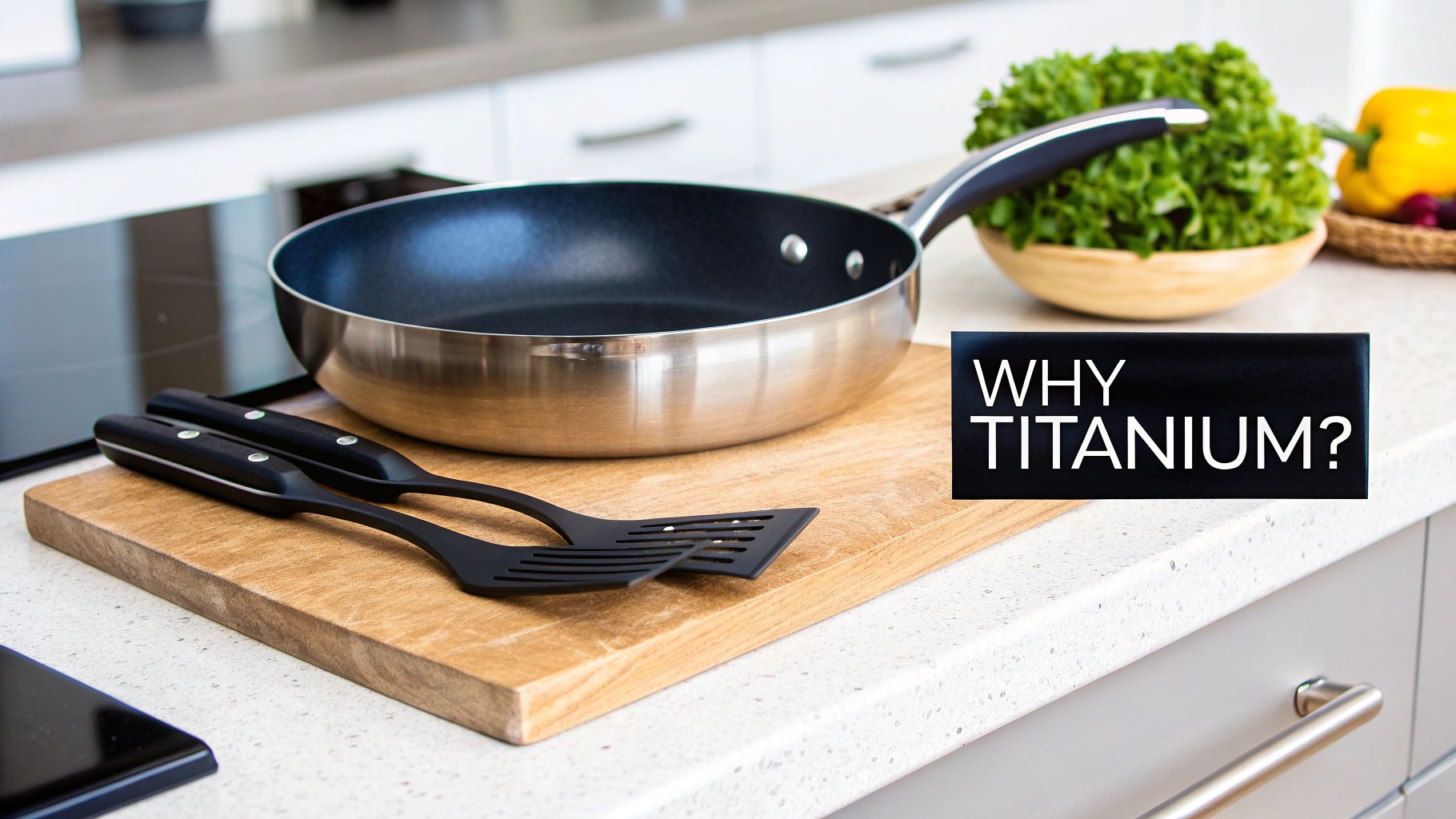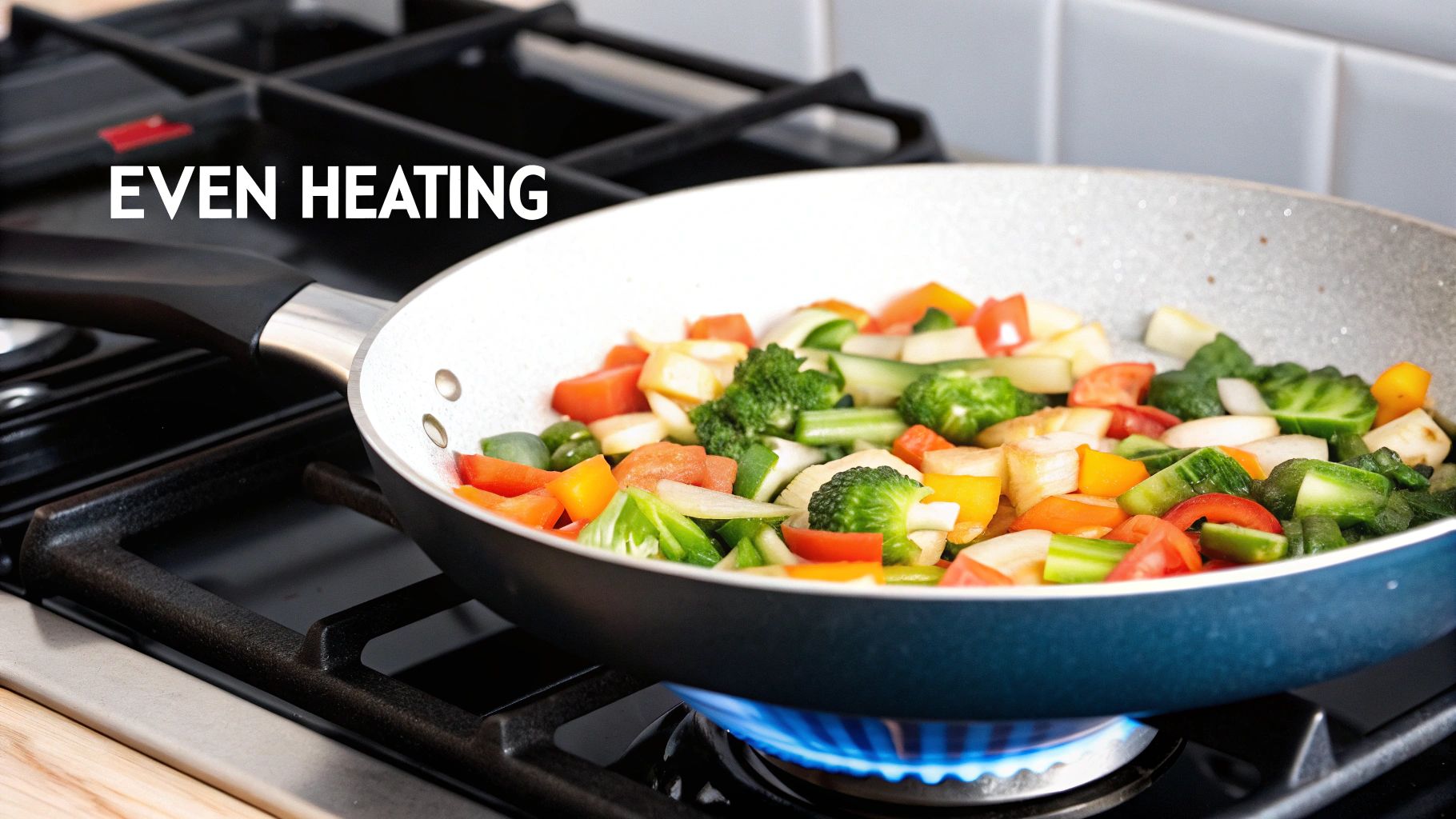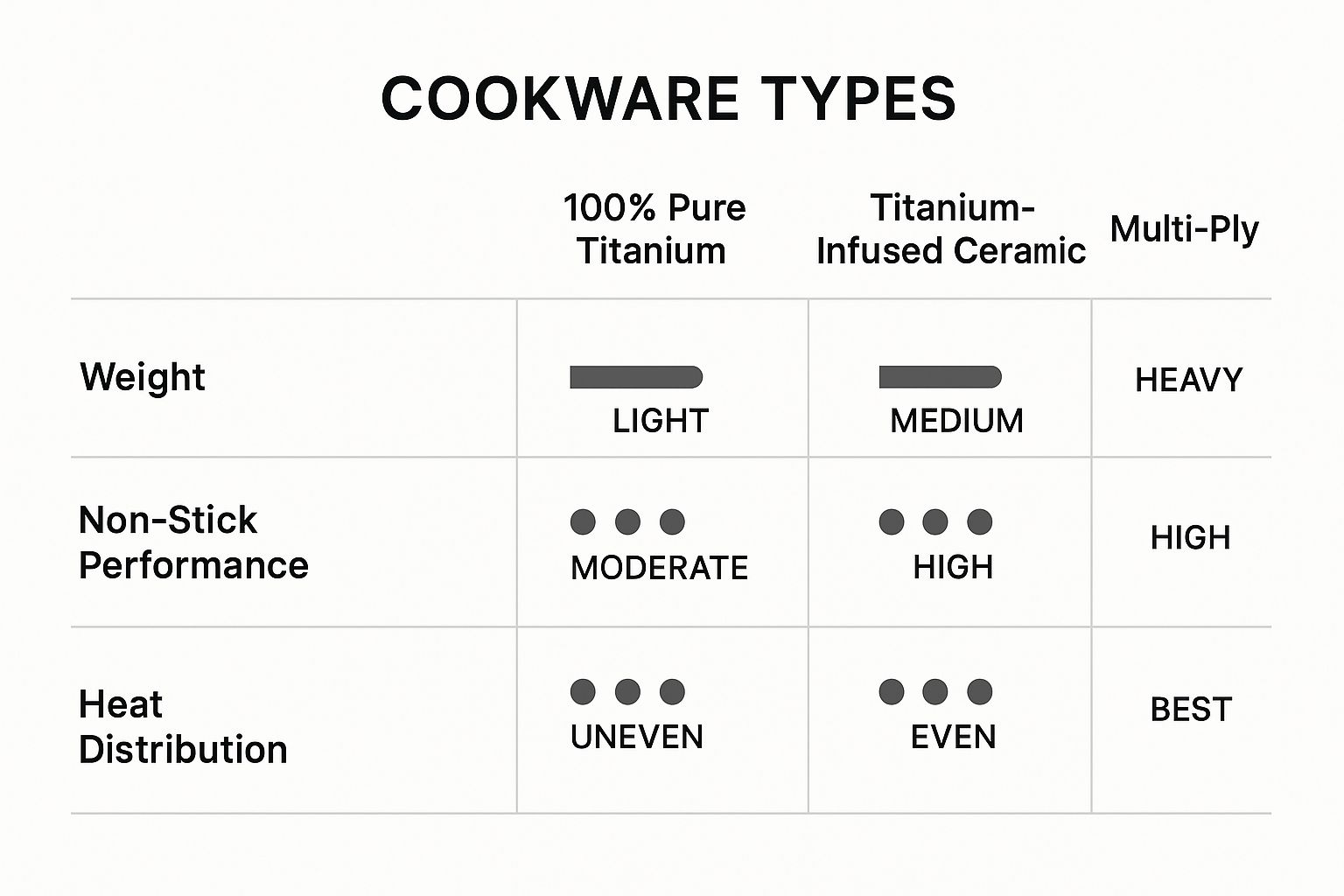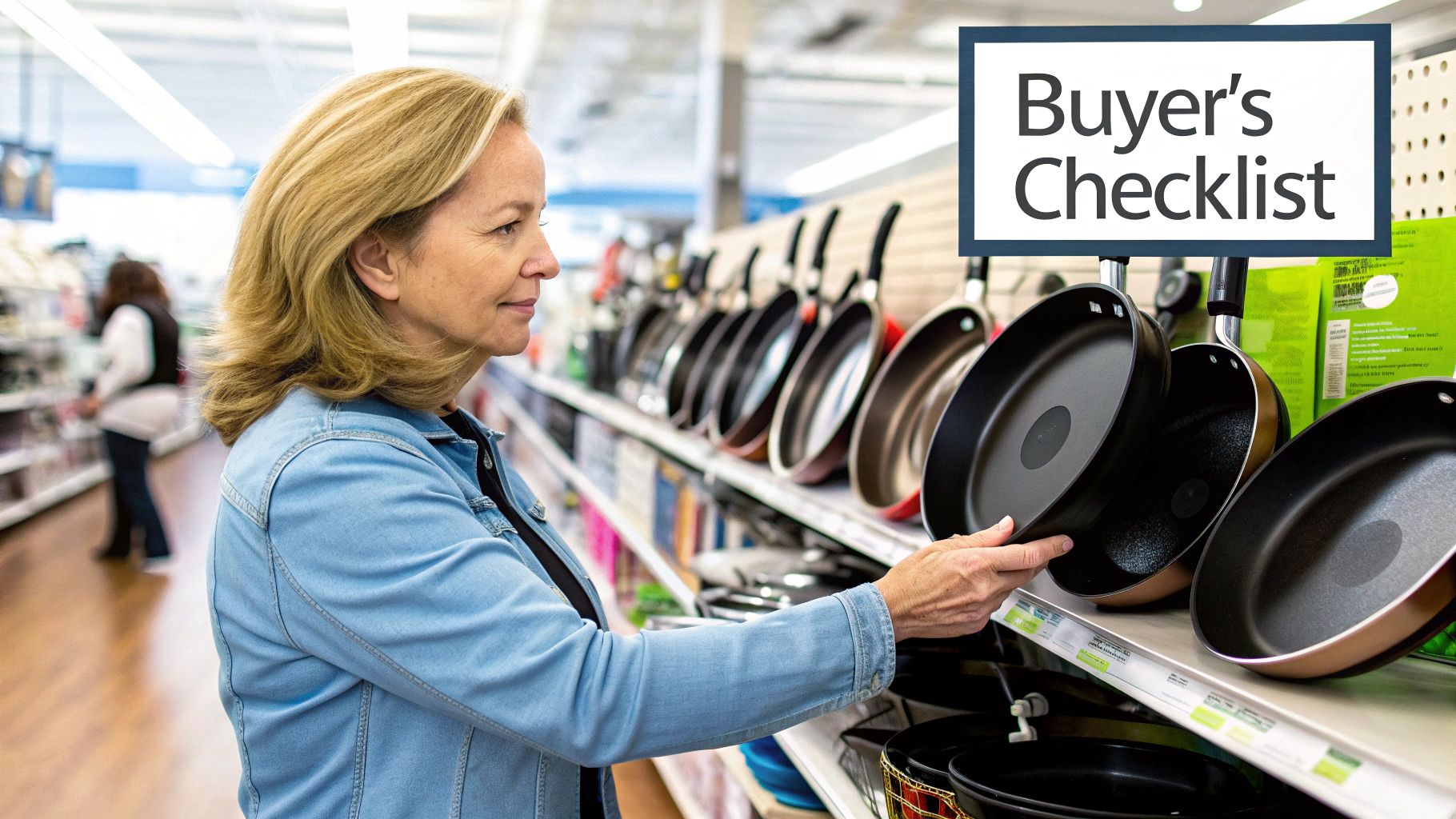If you're on the hunt for premium titanium cookware in Australia, you’re probably looking for that perfect blend of toughness and lightweight handling. This modern material has made a name for itself due to its incredible strength and non-toxic nature, quickly becoming a favourite for both health-conscious home cooks and seasoned chefs.
What Is Titanium Cookware and Is It Right for You?

Dipping your toes into the world of high-end kitchen gear can feel a bit overwhelming, but there are solid reasons why titanium is winning over so many Australian kitchens. Think of it as the Formula 1 car of the culinary world—it’s engineered for performance, surprisingly light, and incredibly strong. This isn't just another pan; it’s a genuine upgrade in how we think about cooking technology and food safety.
The real heart of titanium's appeal is that it’s biocompatible. In simple terms, this means it’s completely non-toxic and won't have a chemical chat with acidic foods like tomatoes or lemon juice. Your food tastes precisely how you intended it to, with no strange metallic aftertaste. That's a huge step up from other materials that can sometimes leach unwanted bits and pieces into your dinner.
The Appeal for Modern Home Chefs
So, what's all the fuss about? For most Aussies, the switch to titanium boils down to a few key benefits that perfectly suit a modern, health-aware lifestyle.
- Purity and Safety: It’s naturally free from nasties like PFOA, lead, and cadmium, which are often lurking in older non-stick coatings.
- Built to Last: Titanium has a legendary strength-to-weight ratio. It stands up to warping, scratching, and rust far better than most other pans, making it a smart, long-term investment for your kitchen.
- A Joy to Handle: Despite being so tough, it’s significantly lighter than a hefty cast iron skillet. This makes everyday cooking, from flipping pikelets to tossing a stir-fry, feel effortless.
If you want to get into the nitty-gritty, exploring the pros and cons of using titanium cookware is a great way to get the full picture before you buy. Having a balanced view is key to knowing if it’s the right fit for your cooking style.
The real magic of titanium lies in its unique combination of talents. It gives you the fantastic searing power you’d expect from stainless steel, but with the added benefits of being more resilient and having a safer, non-reactive cooking surface. It’s truly made for cooks who refuse to compromise on performance.
Ultimately, choosing titanium cookware is an investment in quality that lasts and peace of mind. If you're someone who values durable, non-toxic, and high-performing gear, this advanced material is definitely worth a serious look. It’s designed not just to last a few years, but to be a reliable partner for a lifetime of family meals and kitchen experiments. This guide is here to help you figure out if it’s the right move for you.
Why Australian Kitchens Are Embracing Titanium

It’s easy to get lost in the marketing hype, but the real reason titanium cookware in Australia is gaining so much traction comes down to tangible, everyday benefits. Home cooks are looking past the usual suspects and for good reason—titanium genuinely makes life in the kitchen easier.
Let's cut through the noise and talk about what actually matters when you're searing a steak on a Tuesday night. The perks of titanium aren't just technical jargon; they solve some of the most common frustrations we all face at the stovetop.
Unmatched Durability and Longevity
One of the biggest draws for Aussies investing in titanium is its sheer resilience. Think of it as the 4x4 of your kitchen—it's built to handle whatever you throw at it, day in and day out, without skipping a beat.
Titanium is incredibly resistant to warping, scratching, and corrosion. We’ve all had pans that buckle under high heat or get gouged by a metal spatula, but titanium holds its ground. This turns it into a smart, long-term investment. Instead of replacing worn-out pans every couple of years, you get a piece of cookware that lasts, which is better for your wallet and the environment.
A Pure and Untainted Cooking Surface
For anyone who’s mindful about what goes into their food, titanium's non-toxic and non-reactive nature is a huge plus. This is a game-changer if you care about the purity of your ingredients.
- No Metallic Aftertaste: Titanium is what’s known as biocompatible, which simply means it won't react with acidic foods like tomatoes, wine, or lemon juice. Your food tastes exactly like it's supposed to, without any strange metallic tang.
- Chemically Inert: Good quality titanium cookware is naturally free from things like PFOA, lead, and other nasty chemicals you sometimes find in older non-stick coatings. It offers real peace of mind with every meal.
This non-reactive quality means the pan itself never gets in the way of the flavours you've worked so hard to build.
The real advantage of titanium is that it’s inherently safe. There's no coating to peel or degrade over time. The cooking surface is pure, stable, and won't leach anything into your family's food, which is a major reason for its growing trust in Australian homes.
Superior Heat Management Without the Hot Spots
We’ve all been there—one side of the chicken is burnt to a crisp while the other is still stubbornly pale. Those frustrating hot spots are the enemy of a good meal. Titanium cookware, especially the multi-ply designs that layer it with conductive metals like aluminium, tackles this problem beautifully.
This layered construction spreads heat quickly and evenly across the entire base of the pan. It gets up to temperature fast, saving energy, and then holds that heat consistently. This gives you predictable results, whether you're flipping delicate crêpes or searing scallops. Your food cooks uniformly, putting you back in control.
The Surprising Lightness of a Heavy Hitter
When you think of tough, durable cookware, you probably picture a heavy cast iron skillet. And while cast iron is brilliant, its weight can be a real workout. This is where titanium really shines.
It has an incredible strength-to-weight ratio. A titanium pan gives you all the toughness and searing power you need, but it's noticeably lighter and easier to manoeuvre. This makes it a fantastic choice for everyone, from those with wrist issues to busy parents zipping around the kitchen. Tossing veggies or moving a hot pan from the stove to the oven becomes a simple, safe task, not a weightlifting session.
What Are the Different Kinds of Titanium Cookware?
When you start looking for titanium cookware in Australia, you'll quickly realise it's not a one-size-fits-all situation. The term "titanium" gets used in a few different ways, and understanding the distinctions is the key to picking the right gear for your kitchen.
Think of it like this: not every car with "sport" in the name is a racetrack beast. The same goes for titanium pans. Let's break down the three main types you'll come across so you can see what's really under the bonnet.
Pure Titanium Cookware
This is exactly what it sounds like: cookware made from 100% pure titanium. It's the same stuff you find in high-tech aerospace gear and top-of-the-line camping equipment. Its biggest claim to fame is being incredibly lightweight and ridiculously strong.
But here’s the catch. On its own, pure titanium isn't a great heat conductor. This means you can get hot spots right where the flame hits, making it tricky to cook things evenly. While it's a dream for hikers who need to boil water fast without adding weight to their pack, it's not usually the best choice for getting a perfect, wall-to-wall sear on a steak.
- Best For: Camping, hiking, and situations where weight is the top priority.
- Key Trait: Extremely light and durable.
- Heats Up: Very quickly, but often unevenly.
Titanium-Infused Ceramic Coatings
This is probably the most common type you'll see in Aussie kitchens. These pans aren't made of solid titanium. Instead, they have a base of a heat-conductive metal (usually aluminium) that’s covered with a ceramic non-stick coating.
The "titanium" part comes from tiny particles of the metal being infused into that ceramic layer. This makes the non-stick surface much tougher and more resistant to scratches than a standard ceramic pan. It’s a fantastic everyday option, especially for cooking delicate foods like eggs or fish that have a tendency to stick.
The important thing to remember is that you're getting a super-durable surface, but the pan's heating performance comes from the aluminium core underneath. The quality really depends on both the coating and the base metal.
Multi-Ply Titanium Cookware
Now we're getting to the serious, high-performance end of the scale. Multi-ply (or "clad") cookware is built like a high-tech sandwich, combining the best properties of different metals.
Picture this: a core layer of a fantastic heat conductor like aluminium or copper is bonded between layers of another material. For the cooking surface, you get a layer of pure, non-reactive titanium. This clever construction completely solves the uneven heating problem of pure titanium while keeping all its benefits—it’s non-toxic, tough, and won't react with acidic foods. You get the incredible searing power you'd expect from stainless steel, but without any of the sticking.
This infographic gives a great visual summary of how these types stack up.

As you can see, the multi-ply design delivers the most well-rounded performance, making it a favourite among keen home cooks. Its ability to handle high temperatures also makes it incredibly versatile. Many clad pans can go straight from the stovetop into a hot oven, which is a game-changer for so many recipes. If you want to learn more about what makes cookware safe for the oven, this guide to oven-proof cookware is a great resource.
Comparing Your Titanium Cookware Options
To make the choice a little clearer, here’s a side-by-side look at the common types of titanium cookware. This should help you pinpoint which one best suits your cooking style, needs, and budget.
| Cookware Type | Best For | Heat Conduction | Non-Stick Ability | Durability | Price Guide |
|---|---|---|---|---|---|
| Pure Titanium | Ultralight camping, hiking, boiling water. | Poor to Fair | Low | Exceptional | $$ |
| Titanium-Infused Ceramic | Everyday cooking, delicate foods like eggs and fish. | Good to Very Good | Excellent | Good | $-$$ |
| Multi-Ply Titanium | Searing, all-purpose cooking, stovetop-to-oven recipes, longevity. | Excellent | Good | Exceptional | $$$ |
Ultimately, the best choice really boils down to how you cook. If you just want an easy, non-stick pan for your daily fry-up, a titanium-infused ceramic option is a brilliant and affordable choice. But if you’re looking for professional-level performance and a piece of cookware that will genuinely last a lifetime, multi-ply titanium is the undisputed champion.
How to Choose the Best Titanium Cookware in Australia

Navigating the world of titanium cookware in Australia can feel a bit overwhelming at first, but figuring out the right fit for your kitchen is actually pretty simple once you know what to look for. Think of this as your personal checklist to help you pick a piece that you'll love using every day.
Remember, buying quality cookware is an investment. You're not just getting a pan; you're choosing a partner for thousands of meals to come. By focusing on a few key areas—from cooktop compatibility to safety—you'll end up with cookware that's a genuine pleasure to use for years.
Check Your Cooktop Compatibility
First things first. Before you get your heart set on a particular pan, you absolutely must check if it works with your stove. Not all cookware materials are friends with every heat source, and this is especially true for the induction cooktops popping up in more and more Aussie homes.
- Induction Cooktops: These clever hobs use magnets to generate heat, so they need cookware with a magnetic base. Pure titanium and many pans with an aluminium core won't work on their own. You'll need to look for multi-ply construction that includes a magnetic stainless steel layer on the outside. Always double-check the product details for an "induction-compatible" label.
- Gas and Electric Stoves: These are much less fussy. Almost all titanium cookware, including those with aluminium cores, will perform beautifully on traditional gas flames, electric coils, or smooth ceramic hobs.
Here’s a handy trick: grab a fridge magnet and see if it sticks firmly to the bottom of the pan. If it does, you’re cleared for induction cooking.
Prioritise a Toxin-Free Cooking Surface
Let’s be honest, a big reason many of us are switching to titanium is for healthier cooking. That means finding cookware that is guaranteed to be free from the nasty chemicals you sometimes find in older non-stick coatings.
Always make sure the cookware is PFOA-free. Perfluorooctanoic acid (PFOA) was a chemical commonly used to make non-stick surfaces, but it has been linked to various health concerns. Any reputable brand today will make it crystal clear that their products are non-toxic.
This shift towards safer materials is a huge global trend. The worldwide cookware market was valued at around $10.22 billion in 2023 and is only expected to climb as more people look for durable, high-quality options. We’re seeing this right here in Australia, where home cooks are choosing to invest in quality that lasts.
Examine the Finer Details
It’s often the small things that make the biggest difference in how much you enjoy using your cookware every day. Take a close look at the design of the handles and lids, because they have a huge impact on comfort, safety, and how your food turns out.
Handles: You want handles that feel good in your hand—something ergonomic that gives you a secure grip. They should be attached solidly, usually with rivets, so they won't wobble or come loose after years of use. Handles made from heat-resistant materials like stainless steel or those wrapped in silicone are a massive bonus, saving you from constantly reaching for an oven mitt.
Lids: A snug-fitting lid is non-negotiable. It’s what traps heat and moisture, which is crucial for everything from simmering a sauce to braising meat. Tempered glass lids are fantastic because they let you keep an eye on your food without lifting the lid and letting all that precious heat escape.
Find Reputable Sellers and Beware of Fakes
When you’re ready to buy titanium cookware in Australia, stick with sellers you trust. This means heading to specialised kitchenware shops, well-known department stores, or buying directly from the brand's official website. It’s your best guarantee of getting an authentic product and having customer support to back you up.
Unfortunately, with popularity comes knock-offs. The market has seen a rise in misleading products, so it pays to be a savvy shopper. Make sure you know what you’re looking for by reading our guide on the growing fake titanium scam in Australia. A genuine piece will always have clear, detailed information about its materials and construction.
Keeping Your Titanium Cookware in Perfect Condition
When you invest in a premium piece of cookware, you're buying something for the long haul. With just a little care, your titanium pans can genuinely last a lifetime. The best part? Maintaining titanium cookware in Australia is surprisingly simple. You can forget about complicated cleaning rituals; a few basic habits are all it takes to keep your pans performing beautifully for years to come.
Think of it like looking after a high-quality chef's knife. It's built to be tough, but treating the material with a bit of respect is what keeps it at its peak. These simple practices will protect the cooking surface, maintain its incredible performance, and make sure every meal you cook is as good as the first.
Getting Started The Right Way
Before you even think about frying your first egg, a quick prep step will set your new pan up for success. This isn't a complex seasoning process like you'd do with cast iron, but more of a simple first clean to get the surface ready for action.
- Wash and Dry: Start by giving your new pan a gentle wash with warm, soapy water and a soft sponge. This just removes any dust or residues from the manufacturing and shipping process.
- Rinse Thoroughly: Make sure you rinse away every last bit of soap. Any leftover film can interfere with the pan's performance.
- Dry Completely: Use a soft tea towel to dry the pan completely before you use it for the first time.
That's it. This quick routine ensures you’re starting with a pristine cooking surface, ready to deliver clean, pure flavours from day one.
Daily Cleaning Habits for Longevity
To keep your titanium cookware in top shape, hand washing is always your best bet. While many brands say their pans are dishwasher-safe, the harsh detergents and high heat inside a dishwasher can dull the finish over time. A quick hand wash gives you much better control.
The most important thing to remember is to always let your pan cool down before washing it. Plunging a hot pan straight into cold water causes something called thermal shock, which can lead to warping over time—even with a material as tough as titanium.
The golden rule of titanium care is patience. Let it cool naturally for a few minutes on the stovetop before taking it to the sink. This small step is the single best thing you can do to preserve the pan’s structure and ensure it stays perfectly flat for years.
If you have some stubborn, stuck-on food, resist the urge to grab the steel wool. Just fill the pan with warm, soapy water and let it soak for 15-20 minutes. This will loosen almost anything, allowing you to wipe it away easily with a non-abrasive sponge or a soft bristle brush.
Choosing the Right Tools
The durability of titanium is legendary, but that doesn't mean it's invincible. Protecting the cooking surface from deep scratches is the key to its longevity, especially if your pan has a non-stick coating.
- Silicone Utensils: These are the perfect match for titanium. They’re gentle on the surface and won't cause any scratches.
- Wooden or Bamboo Spoons: A classic choice that’s safe for all types of cookware, titanium included.
- Avoid Metal Utensils: While titanium is very scratch-resistant, it's not completely scratch-proof. Constantly scraping it with metal forks or spatulas can eventually wear down and damage the surface.
By pairing your premium cookware with the right tools, you create a kitchen system that works in harmony. These simple habits ensure your investment continues to pay off with countless delicious meals.
Got Questions About Titanium Cookware?
Thinking about making the switch to titanium? It's a big step, and you've probably got a few questions buzzing around. That's completely normal. To help you figure out if it’s the right move for your kitchen, we've gathered the most common queries we hear from Aussie home cooks just like you.
Let's dive into the nitty-gritty, covering everything from safety and performance to the day-to-day realities of using it.
Is Titanium Cookware Actually Safe?
Yes, absolutely. In fact, safety is one of the top reasons people are drawn to it. Titanium is widely regarded as one of the safest cookware materials out there because it's both biocompatible and non-reactive.
What does that really mean? Simply put, it won’t react with your food. You can simmer a rich, acidic tomato sauce or squeeze in lemon juice without worrying about the pan leaching metals or altering the taste of your dish. High-quality titanium cookware is also free from nasties like PFOA, lead, and cadmium.
Will My Food Stick to a Titanium Pan?
That really comes down to the type of pan you have and how you use it.
- Coated Titanium: If your pan has a titanium-infused non-stick coating, you'll get fantastic food release. It’s a dream for delicate foods like eggs and fish fillets.
- Uncoated Titanium: Pure titanium, or pans with a titanium cooking surface (like multi-ply), behave more like high-end stainless steel. They don’t have that slick coating, but you can build up an amazing non-stick surface with the right technique. The trick is to preheat your pan for about 90 seconds on medium heat, then add a small amount of a high-smoke-point oil just before you put your food in.
A classic rookie mistake is trying to move food around too soon. With uncoated titanium, food will stick at first and then release itself once it has formed a beautiful crust. If it’s stuck, give it another 30 seconds—it’s probably not ready to be flipped.
Can I Use Metal Utensils on My Titanium Pans?
Even though titanium is famously tough, it's not invincible. The general rule is to steer clear of metal utensils, especially on any coated surfaces, as they can cause fine scratches over time.
To keep your cookware looking and performing its best for years, stick to silicone, wood, or bamboo utensils. They’re much kinder to the cooking surface and will help preserve its integrity.
Do I Have to Season Titanium Cookware Like Cast Iron?
Nope! This is one of the great things about it. Titanium cookware doesn't need the elaborate seasoning ritual that cast iron demands. You can forget about baking on layers of oil to build up a non-stick patina.
All you need to do is give it a quick wash with warm, soapy water before its first use to get rid of any factory residue. From then on, it’s just that simple preheat-and-oil trick before you start cooking. It’s far less fuss to maintain than traditional cast iron.
Ready to see what pure, durable, and non-toxic cooking feels like? Explore the full range of lifetime essentials at Everti and find out why so many Australian cooks are upgrading their kitchens. Shop the collection today.
Article created using Outrank

